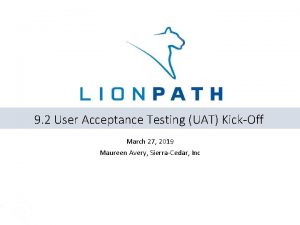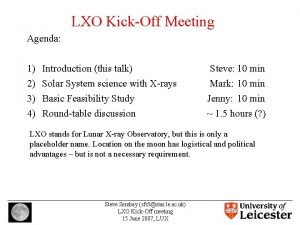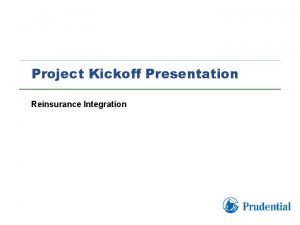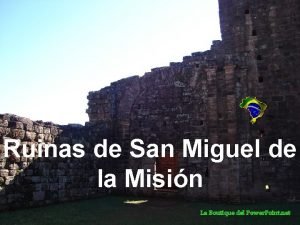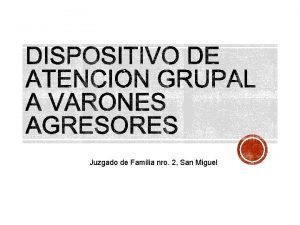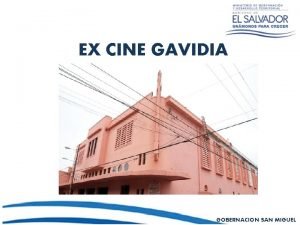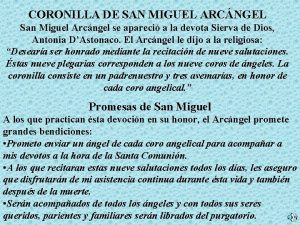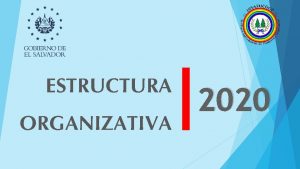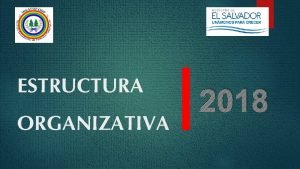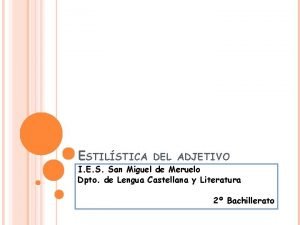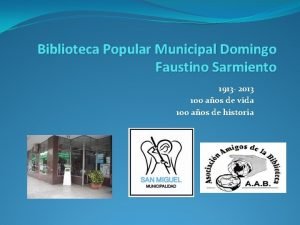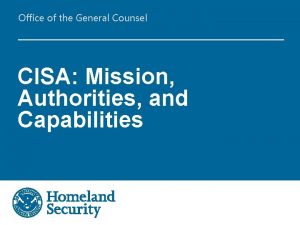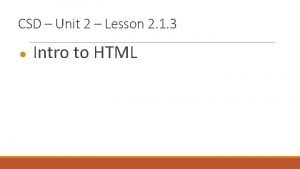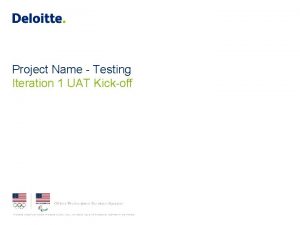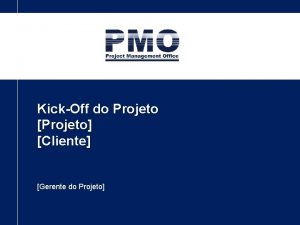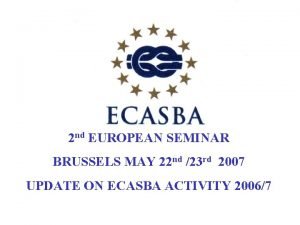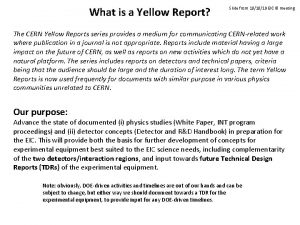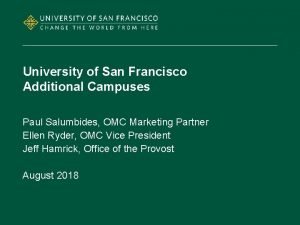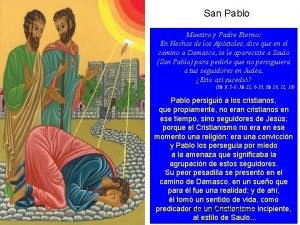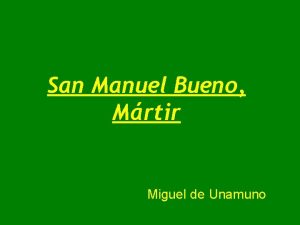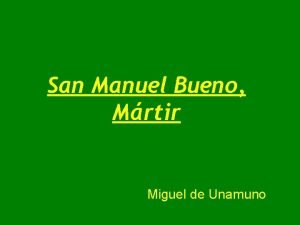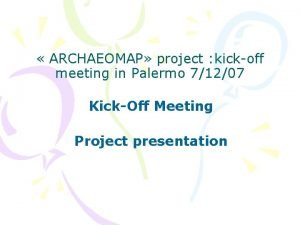San Miguel CSD CREST WORKSHOP Kickoff Meeting Outline


























































- Slides: 58

San Miguel CSD CREST WORKSHOP Kickoff Meeting

Outline for meeting ▪ Go over the background and lead up to this meeting. ▪ Go over what is CREST. ▪ Give an overview of which plans affect us.

Background

How did we get here? Timeline of area: ▪ 1797: Mission San Miguel is founded. ▪ 1886: Railroad arrives in San Miguel. ▪ 1887: Original townsite of San Miguel burns down. ▪ 1889: City of Paso Robles is formed. ▪ 1890: Templeton Fire District is formed. ▪ 1899: San Miguel Fire District is formed. ▪ 1899: Templeton Sanitary District is formed.

1910 to 1939 ▪ 1910: San Miguel Lighting District is formed. ▪ 1913: The Atascadero Colony is formed as a utopian community. ▪ 1922: County Waterworks 1 is formed, serving San Miguel. ▪ 1934: Templeton Lighting District is formed. ▪ 1937: Paso Robles Cemetery District is formed. ▪ 1939: San Miguel Cemetery District is formed.

1940 to 1945 ▪ 1940: Army Core of Engineers construct sewer system for San Miguel. ▪ 1941: Camp Roberts opens. ▪ 1942: San Miguel Sanitary District is formed. ▪ 1944: Peak troop population of about 45, 000 is reached at Camp Roberts. ▪ 1945: Atascadero Fire District is formed.

1951 to mid 1950 s ▪ 1951: County Waterworks 5 is formed to serve Templeton. ▪ 1954: Atascadero Garbage District is formed. ▪ 1954: Camp Roberts starts scaling down. ▪ 1954: SLO County gives up rights to dam Lake Nacimiento to Monterey County on condition SLO County gets 20, 000 acre feet of water. Monterey County reneges on the deal. ▪ Mid 1950 s: 101 freeway bypasses many downtowns, local economies impacted.

1957 to 1968 ▪ 1957: San Miguel Sanitary District acquires sewer plant from Camp Roberts. ▪ 1958: Atascadero Sewer District is formed. ▪ 1959: SLO County and Monterey County begin a water war after it was proposed to create lake San Antonio. ▪ 1968: A massive flood destroys the San Miguel sewer plant and bridge across the Salinas River isolating the San Lawrence Terrace from the rest of San Miguel.

Late 60 s to Mid 70 s ▪ Late 60 s early 70 s: Templeton embarks on a shared sewer plant project with Paso Robles. Apparently missed in the fine print was that Paso Robles would own the sewer service to Las Tablas Road, starting the annexation wars between Paso and Templeton. ▪ 1970: Camp Roberts is officially closed. ▪ 1971: National Guard acquires Camp Roberts. ▪ Mid 1970 s: many historical buildings in San Miguel either torn down or set on fire.

Mid 1970 s to 1979 ▪ Mid 1970 s City of Paso Robles annexes large tracts of lands. ▪ 1975: Almond Industry starts to shut down, impacting Paso’s economy. ▪ 1976: Templeton CSD is formed. ▪ 1977: Twin Cities Hospital is built. ▪ 1978: Prop 13 passes dramatically affecting government revenues. ▪ 1979: City of Atascadero is formed.

1980 to 1982 ▪ 1980: San Miguel considers forming a CSD. County gives dismal report on town, threatens to shut off lights. West 10 th Street removed from Water District Area. ▪ 1982: San Miguel Fire District on verge of financial bankruptcy considers annexing the San Lawrence Terrace.

1982 to 1983 ▪ 1982: City of Paso Robles proposes to annex from Wellsona Road to the Templeton Cemetery. Paso gains control over disputed territory between Templeton and Paso Robles denied Wellsona Annexation. ▪ 1983: San Lawrence Terrace is annexed by San Miguel Fire District.

1990 to 1993 ▪ 1990 s: Templeton and Heritage Ranch attempt incorporation, declared unfeasible. ▪ 1992: State educational fund implodes; state takes property tax money away from local agencies. ▪ 1992: Revenue neutrality law passes impacting incorporations. ▪ 1993: Prop 172 passes, dedicating. 5% of sales tax to cities and counties, special districts left out.

1999 to 2003 ▪ 1999: San Miguel CSD is formed. Sanitary District starts upgrades at sewer plant ending building moratorium. ▪ 2000: Measure to dissolve Sanitary District passes by 1 vote. legal battle breaks out between CSD and Sanitary District. ▪ 2001: Sanitary District is finally merged with CSD. ▪ 2003: Original Community Design Plan is crafted.

2004 to 2008 ▪ 2004: Financial problems hit San Miguel CSD. ▪ 2004: Proposed Cayucos CSD fails by a landslide. ▪ 2005 Nipomo CSD considered incorporation. Declared financially unfeasible. ▪ 2006: Los Osos CSD Declares bankruptcy over its ongoing sewer saga. ▪ 2007: Construction begins on Lake Nacimiento Pipeline Project. Providing water to Paso, Templeton, Atascadero, San Luis Obispo, and Cayucos. San Miguel opts out over costs. ▪ 2008: Great Recession hits, housing markets implode wiping out property tax income.

2008 to 2017 ▪ 2010: Paso Basin declared to be in overdraft. ▪ 2012: Almond Acres opens. ▪ 2014: State passes new rules for groundwater use. ▪ 2016: Special election for Paso Groundwater Basin District fails in a landslide vote. ▪ 2016: A remastered Community Design Plan for San Miguel is adopted by the county. ▪ 2017: The Shandon San Juan and Estrella, Creston, and El Pomar Water Districts are formed.

2018 to 2019 ▪ 2018: Cayucos Fire District disbands over funding issues. ▪ 2018: San Miguel CSD starts path on sewer plant expansion. ▪ 2019: Templeton finally cuts its sewer service with Paso Robles. ▪ 2019: Templeton holds a special election to fund full time fire fighters. It passes. ▪ 2019: Financial outlook for San Miguel CSD stabilizes.

2020 ▪ 2020: San Miguel CSD takes on downtown landscaping. ▪ 2020: San Miguel CSD purchases new fire engine and looks at housing for firefighters. ▪ 2020: Templeton considers incorporation again, declared unfeasible. ▪ 2020: Templeton completes its 3 -year strategic plan, declares board dysfunction is a weakness of theirs. ▪ 2020: Oceano CSD kicked out of Five Cities Fire Authority after property tax increase fails. ▪ 2020: COVID-19 severely impacts Paso’s revenue sources and seeks a 1% sales tax increase on the ballot. ▪ 2020: Almond Acres Charter Academy, gets approval to leave San Miguel.

Timeline Summary ▪ San Miguel had a long boom cycle from 1900 to 1954 and was more developed than Templeton and Atascadero. ▪ Most Incorporation attempts have failed due to not being financially feasible. None of the communities mentioned have a large commercial district nor planned long term to incorporate. ▪ Paso has a history of aggressive expansion ▪ Financial problems plague most governments ▪ Most governments failed to be proactive about long term challenges ▪ CSDs have been left out when it comes to state funding

So what was the outcome from all this?

Community Profile of San Miguel (2010 census data) ▪ Population of 2, 336 ▪ 51% of the community is Latino ▪ 23% of community lives in poverty ▪ 52% of the community rents ▪ Median home value is $425, 000 (PR City is $525, 000 and Templeton is $640, 000)

CSD Boundaries

CSD Services San Miguel Cambria Fire X X Lighting X X Water X X Sewer X Garbage X Heritage Avila Templeton X X X X X Drainage X Parks Landscape Memorial Nipomo X X X X

Urban Reserve Line Area

Tax rate boundaries

Income from each tax rate area

Tax Rate Areas ▪ Some areas pay more for fire service than other areas. ▪ Some areas pay property taxes for sewer on top of their sewer bill. Others don’t. ▪ Large areas on the east side of the river have no current funding source for other services, such as streetlights. ▪ This is a result of merging all the old special districts together. Most other CSDs and city’s have a general fund. San Miguel does not. ▪ Fire, Lighting/Landscaping, and Sewer funds are affected by property taxes.

TRA Templeton vs San Miguel

TRA Templeton vs San Miguel the effects ▪ A $640, 000 home will only pay $637. 44 to the Templeton CSD. ▪ A $425, 000 home will pay $ 943. 07 to the San Miguel CSD.

Where do we go from here?

What is CREST? ▪ Community ▪ Reinvestment ▪ Empowerment ▪ Services ▪ Toolkit

What is CREST based on? ▪ It is based on “The Strong Towns Approach”.

Why CREST?

What will CREST do? ▪ Identify small low-cost projects that the CSD could easily act on. ▪ Develop tools for building community wealth in underperforming neighborhoods. ▪ Empower the community with buy in. ▪ Empower the CSD Staff and Board with the flexibility to innovate and prepare for future challenges to the district. ▪ Encourage innovation in the community. ▪ Make the community and CSD more fiscally resilient. ▪ Set a clear vision and mission for the San Miguel CSD

Why CREST vs. a Strategic Plan or Master Plan? ▪ CREST is based on developing smaller more actionable projects vs larger or more abstract projects. ▪ CREST is designed to be more user friendly versus the several thousand pages of existing plans affecting San Miguel. ▪ Strategic Plans and Master Plans can “sit on the shelf” for 20 years or more. ▪ CREST would identify costs for projects and their impacts on the community. ▪ Strategic Plans and Master Plans can be expensive.

Examples Traditional Plan vs CREST?

Have we done CREST style projects before? ▪ Mattress and E Waste Recycling. ▪ Trash cans downtown. ▪ Repairing and maintaining the downtown landscaping.

How do we know what neighborhoods to reinvest in?

Value Per Acre

Value Per Acre ▪ Infrastructure costs money, regardless of how many buildings are on a block. ▪ Infrastructure costs money, even in front of a vacant lot. ▪ Some neighborhoods are a financial drain on revenues. ▪ Value is comprised of the land the improvements on it.

Value Per Acre ▪ What neighborhoods generate the biggest financial return for the CSD? ▪ What building in San Miguel generates the most financial benefits for the CSD and community regarding relative to its size?

Value Per Acre

Value Per Acre

What can we do about value per acre? ▪ Land values are affected by government decisions and actions, the more services provided the more desirable the land is. ▪ Alternatively, a government can modify its approach to public utilities, turning them directly into desirable locations. ▪ Conversely if a government doesn’t actively work in a community, land values can depreciate, resulting in less revenues. ▪ A government can also use its impact fees and taxing powers to make neighborhood more fiscally efficient.

What can we do about value per acre? ▪ This is a part of the reinvestment and services part of the CREST Toolkit.

Example 1: Street Trees

Example 2: Santee Lakes ▪ Recreational lake for boating, camping and fishing. ▪ People pay up to $200 a night to camp here. ▪ Is actually a sewer infiltration pond.

Example 2 continued

Comments?

2012 LAFCo Service Review for San Miguel CSD ▪ LAFCo : Local Agency Formation Commission ▪ Oversees boundaries for CSDs and Cities, also controls what services they provide. ▪ New Service Review for San Miguel is due this year. ▪ The actions and decisions of our board during these meetings will greatly impact this report.

2016 San Miguel Community Design Plan ▪ Designed to be an upgrade from the original town plan of 2003. ▪ Is a comprehensive plan covering topics including: Economic Development, Parks, Public Safety and Infrastructure. ▪ Many programs and policies in the plan. ▪ Chapters 3, 4, 6, 7, 8 & 9 directly reference the CSD ▪ Projected a population of 3, 500 by 2035. San Miguel is at about 3, 000 now. ▪ Had programs and policies put in that the community objected to.

2018 Special District Fire Study ▪ Created after Cayucos Fire Department disbanded. ▪ Designed to look at the fiscal health of fire departments in unincorporated communities. ▪ Was intended to identify projects to support those fire departments, including projects for San Miguel Fire.

2018 IWMA Regional Strategy ▪ IWMA: Integrated Waste Management Authority. ▪ Same group that created the plastic bag ban. ▪ This strategy plan is designed to set recycling goals for cities and CSDs with trash service to meet. ▪ If the region doesn’t meet its recycling goals, more bans are likely. ▪ 13 -member board is made up of all 5 supervisors, all 7 cities and one CSD representative.

2019 Paso Basin Sustainability Plan ▪ Governs the CSDs use of groundwater supplies. ▪ Includes big projects not likely to happen. ▪ State mandated.

2020 CSD Water and Sewer Master Plan ▪ Will affect water and sewer utilities. ▪ Board will get to review this plan at our regular board meeting.

Government Code 61100 ▪ This is the law that governs what services the San Miguel CSD can provide to the community. ▪ There are 32 Services a CSD can provide. ▪ The state also grants additional special powers to other CSD. As an example, some CSDs enforce CC and R’s. ▪ Needs LAFCo to review.

Government Code 53313 and 53313. 5 ▪ This allows a CSDs to create a facilities district to finance services and infrastructure. ▪ Examples: Fire Service or Natural Gas Pipelines. ▪ Allows a CSD to pick and choose what properties get service. ▪ Allows a CSD to partner with another agency like a school, county, utility company, or another CSD. ▪ Can be used as an alternative to impact fees. ▪ Does not need LAFCo to review.

Next Steps ▪ Set next meeting date.
 San miguel csd
San miguel csd Proposal kickoff meeting agenda
Proposal kickoff meeting agenda Mentoring meeting agenda
Mentoring meeting agenda Uat kick off
Uat kick off Proposal kickoff meeting agenda
Proposal kickoff meeting agenda Gambar
Gambar Project kickoff meeting presentation
Project kickoff meeting presentation Mentoring kick off meeting
Mentoring kick off meeting Quien es san miguel
Quien es san miguel Pestel analysis of san miguel corporation
Pestel analysis of san miguel corporation Ruinas de san miguel
Ruinas de san miguel Frases del hermano miguel
Frases del hermano miguel Juzgado de familia 2 san miguel telefono
Juzgado de familia 2 san miguel telefono Gobernacion de san miguel
Gobernacion de san miguel Salutaciones a san miguel arcángel
Salutaciones a san miguel arcángel Cp san miguel orkoien
Cp san miguel orkoien Why did charlesfort fail
Why did charlesfort fail Organigrama ani
Organigrama ani Asesores de insafocoop
Asesores de insafocoop Ies san miguel de meruelo
Ies san miguel de meruelo Colegio san miguel gijon
Colegio san miguel gijon Biblioteca de san miguel
Biblioteca de san miguel Tot calderes
Tot calderes Beth dryer
Beth dryer Csd uat
Csd uat Cisa crr
Cisa crr Johnstoncsd
Johnstoncsd Csd unit 2 - web development
Csd unit 2 - web development Unique registration reference nr csd
Unique registration reference nr csd Csd commodity list
Csd commodity list Johnston community schools
Johnston community schools Csd csr
Csd csr Csd uww
Csd uww University of liverpool csd
University of liverpool csd Wyoming csd
Wyoming csd Wcu csd
Wcu csd Nucleation rate units
Nucleation rate units Csr csd
Csr csd Csd remote access
Csd remote access Mock interview workshop outline
Mock interview workshop outline For todays meeting
For todays meeting What is meeting and types of meeting
What is meeting and types of meeting What is meeting and types of meeting
What is meeting and types of meeting Uat kick off meeting
Uat kick off meeting Kickoff projeto
Kickoff projeto Kickoff drills
Kickoff drills Fast kickoff training code
Fast kickoff training code Yellow report eic
Yellow report eic Kickoff projet
Kickoff projet Kickoff 168
Kickoff 168 Ava's kickoff
Ava's kickoff Quotation sandwich examples
Quotation sandwich examples Usf sacramento
Usf sacramento Qué opinas acerca de san pedro y san pablo
Qué opinas acerca de san pedro y san pablo Istituto comprensivo san salvatore telesino
Istituto comprensivo san salvatore telesino Escuela san pedro claver teusaquillo
Escuela san pedro claver teusaquillo Crest in waves
Crest in waves Queens university crest
Queens university crest Queen's university crest
Queen's university crest



